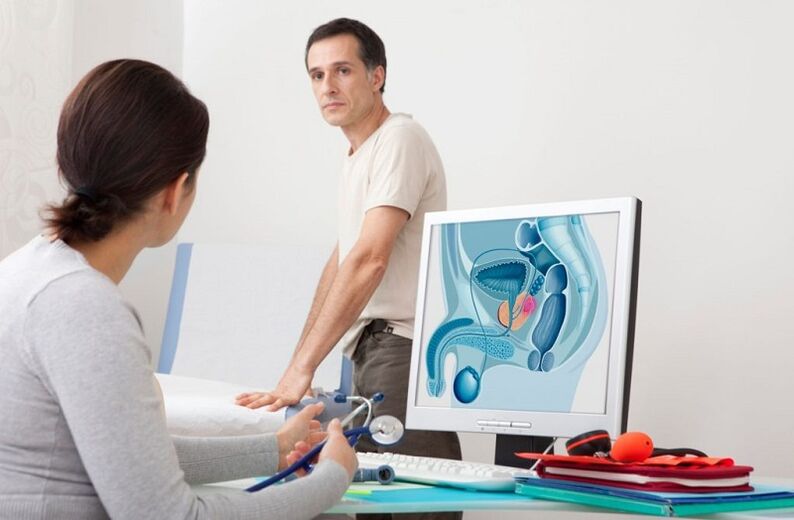Acute prostatitis is an infectious and inflammatory disease that covers the tissues of the prostate gland, causing widespread swelling and the appearance of foci of pus. The disease can manifest itself in different ways, depending on its stage of development. Therefore, an integrated approach is required for accurate diagnosis. Treatment of acute prostatitis usually relies on medication and physical therapy techniques.
The reasons

Alcoholism can cause acute prostatitis.
The disease usually develops in men over the age of 30. In most cases, the disease develops due to the negative effect of pathogenic microflora on the male body. Thus, acute prostatitis in men can be triggered by the activity of the following microorganisms:
- Staphylococcus aureus;
- Pseudomonas aeruginosa and Escherichia coli;
- klebsiella;
- cocci;
- Proteus.
Most of the above microorganisms are regularly present in the human body, while no inflammation is observed. If such bacteria get into the tissues of the prostate gland, their active reproduction begins, as a result of which severe inflammation develops in the prostate gland.
Bacterial entry into the genitourinary system can occur during unprotected sex. Therefore, it is very important for people without sexual partners to regularly use condoms.
Inflammation can also be non-infectious, developing for the following reasons:
- fat;
- sedentary lifestyle;
- rare sexual intercourse;
- significant hypothermia;
- interruption of intercourse;
- Eating disorder;
- smoking and alcohol abuse.
The above factors create fertile ground for the secretion of the prostate to stall. At the same time, stagnant blood processes are noted in the vessels located immediately near the organ.
With a significant accumulation of prostatic secretions, a favorable environment is created for the reproduction of pathogenic microflora. As a result, the development of the inflammatory process occurs. The latter can cause a number of complications, such as:
- Brown planthoppers;
- abscess;
- oncological process.
Important!In the setting of acute prostatitis, most men develop capacity problems and are at risk of infertility.
Therefore, in the risk group for developing this disease are people who:
- not having a regular sex life;
- lack of physical activity;
- have bad habits.
Forms and stages

For any unpleasant symptoms of the prostate gland, you should immediately go to the hospital.
In modern medicine, there are three main stages of this disease. Let's look at them in more detail:
- The first stage is called catarrhal.It is characterized by the appearance of a primary inflammatory process with the appearance of edema of the glandular tissue, enlargement of the acini. In this case, the prostate gland increases in size. If the disease is left untreated, the inflammation will gradually move to the excretory ducts of the prostate gland, which connect to the posterior part of the urethra. When the ducts of the prostate gland become inflamed, they gradually narrow and become blocked, making the secretion of prostate fluid a little difficult. At the stage of its catarrhal development, the inflammatory process covers only the mucosal layers.
- This is followed by the follicular phase of the disease.It is characterized by further progression of the inflammatory process, in which the remaining tissues of the organ are gradually involved. As a result, an acute bacterial form of prostatitis develops. In the analysis of urine at this stage of the development of the disease, there is pus. However, despite significant tissue damage, the cystic form of prostatitis responds well to treatment.
- The final stage is called the parenchyma.It is characterized by a destructive change in the tissues of the prostate gland. At the same time, swelling gradually develops, and the inflammatory process eventually covers the entire organ. If the development of the disease reaches this stage, then the course of treatment is very complicated, radical measures are required. Without prompt and adequate treatment, chronic prostatitis can develop.
At the early stages of the development of this disease, a subacute phase is often distinguished. It is characterized by a weak severity of signs, which is explained by low pathogen activity. The disease can stay at this stage for a long time if the patient's body has good resistance. At the same time, the disease in the subacute stage is difficult to diagnose, which is the reason why most patients do not receive timely treatment.
The symptoms
Each form of this disease is characterized by its own symptoms. Therefore, you should consider them separately.
Form of catarrhal

This form of the disease is characterized by frequent urges to walk because of little need.
If the infection has reached the excretory ducts, then at this stage the disease will develop. But despite the fact that the inflammatory process does not extend beyond the mucous membrane, the prostate gland increases in size and swells. In this case, the urethra is compressed.
Symptoms of acute prostatitis at this stage are mild:
- due to the compression of the canal, the patient may notice minor problems with urination;
- at night, the need to urinate becomes more frequent;
- can increase body temperature up to 38 degrees;
- When the patient is in a sitting position, they may feel a heaviness in the perineum.
In some cases, the catarrhal form occurs without severe hyperthermia.
Symptoms of the disease may disappear on their own within a few weeks of development. And most of the patients in this case did not go to the doctor. However, this is rife when the disease turns into a chronic state. Provided that the treatment of acute prostatitis is started promptly, the disease will go away after 10 days.
Capsule form
If the catarrhal stage is left untreated, then the disease develops further, affecting individual lobes of the organ. In this case, pronounced symptoms appear:
- sharp pain when urinating;
- the patient's body temperature is kept at about 38 degrees;
- dull pain appearing in the perineum, spreading to the penis;
- complicated urination;
- The patient has difficulty in defecation due to severe pain.
Since this stage is characterized by a purulent lesion of the prostate gland, filaments of pus can be observed in the urine of the patient. Provided that therapy is conducted in a timely manner, complete cure of the disease at this stage will occur in less than two weeks after the start of the procedure.
Parenchymal form
It is also known as diffusion. Since the inflammatory process covers the entire organ, the following symptoms occur:
- Perineal pain becomes almost unbearable. Periodically, they migrate to the glans of the penis. Some pain may be reduced in the supine position, when the patient presses both legs to the chest.
- Sensation of a foreign body in the rectum. Significant pain during bowel movements. Constipation becomes more frequent, and if the inflammatory process turns into a reactive form, then mucus secretion begins from the anus.
- There are serious problems with urination. In this case, both partial and total urinary retention can occur.
- Body temperature can reach 40 degrees. The patient has chills.
Diagnose

To confirm the diagnosis, several different studies will be required.
The disease is diagnosed by a urologist who performs a comprehensive study involving the following types of procedures:
- physical examination;
- instrumental research;
- research in the laboratory.
During the initial examination of the patient, the specialist palpates the gland. This must be done very carefully, avoiding massage and pressing movements. Otherwise, you could cause significant discomfort to the patient.
The main diagnostic method is a prostate study, which is done by inserting a probe into the rectum. This process allows professionals to obtain the following data:
- determine pain response;
- identification of the main points of destruction;
- confirm or deny signs of purulent tissue fusion;
- assess the shape of the organ and its symmetry, size, and consistency.
As a rule, when palpating the prostate gland, the secret of this organ is marked. Its analysis allows you to accurately determine the presence of an inflammatory process. During the study, the white blood cell count, amyloid body and other components were examined.
- culture of bacteria in urine and urethral discharge with antibiogram;
- PCR study of scraping;
- blood sowing blood culture.
The nature and severity of dyspepsia during acute exacerbations of the disease was assessed by urinary flow measurement.
Ultrasound of the prostate gland with moderate pain can be performed rectally, and in case of severe pain - transabdominal. Ultrasound, the shape, size of the gland, the presence of focal or diffuse changes is evaluated, the stage of the acute inflammatory process is established.
When planning surgery for destructive forms of acute prostatitis, a pelvic MRI should be performed.
Cure
The mainstay of treatment for acute prostatitis is etiotropic therapy. Based on the timely appointment of antibiotics to the patient, this will prevent the further development of pathogenic microflora in the pelvic organs. In addition to medication, patients are prescribed folk remedies and physical therapy procedures. A balanced diet plays an important role in the treatment of acute prostatitis.
Medicine
Treatment of acute prostatitis should include eliminating the infection causing the inflammation. In addition, the task of therapy is to eliminate stagnation and normalize blood circulation.
In most cases, outpatient treatment is applied to patients with acute prostatitis. If the patient has a parenchymal form, hospitalization is required.
Treatment of acute infectious prostatitis involves mandatory antibiotic intake. In this case, the duration of treatment is determined by the specialist, the same as the drugs used.
Antibiotics of different groups have activity against different microorganisms. That is why professional treatment is performed only on the basis of a thorough diagnosis. Thus, the doctor will be able to accurately select the remedy that is effective against a particular pathogen. Most often, treatment is carried out using drugs that belong to these groups:
- fluoroquinolones;
- penicillin;
- macrolite.
The former is considered the most effective. For this reason, they are most commonly used in the treatment of acute prostatitis.
Although antibiotics are the mainstay of treatment, they are not the only drugs used for acute prostatitis. In particular, patients are prescribed antihistamines and beneficial bacteria for the intestines.
At all stages of acute prostatitis treatment, it is very important to stimulate the immune system. For this reason, immunostimulating drugs are prescribed to the patient.
In addition to the above agents, interferon is used to treat acute prostatitis. Such drugs can be administered both in tablet form and by intramuscular injection. The second option is considered more appropriate.
Physical therapy
Under the condition of choosing the right drug for the treatment of acute prostatitis, the severity of the symptoms of this disease will be significantly reduced. To consolidate the results obtained, the following physiotherapeutic techniques are used:
- Microwave and UHF therapy;
- rectal electrophoresis;
- prostate massage.
Folk remedies

Many experts believe that acute prostatitis cannot be cured by traditional medicine. In addition, such self-medication can aggravate the disease, leading to a number of complications. In this case, folk recipes can only be used as a supplement to official medicines. In addition, many pharmaceutical drugs are made from different types of plants.
As a rule, with an acute form of prostatitis, the patient is prescribed various infusions and decoctions. They should be taken orally or used to obtain a healing solution in the shower. The most effective in this case are the following plants:
- Chestnut;
- mother and stepmother;
- horsetail meadow;
- Oak bark;
- Chrysanthemum flowers.
Diet food
The key to curing acute prostatitis is a balanced diet. The inclusion of certain products in a patient's weekly menu is based on the extent of his or her illness. However, regardless of the stage of the disease, the following foods should be excluded from the diet for a while:
- Bacon;
- fried food;
- preservation;
- strong tea and coffee;
- acoholic drink;
- spicy and salty foods;
- fatty fish meat.
Preventive

Sports activities are very useful for the prevention of prostate diseases.
Prevention of acute prostatitis involves the timely elimination of the inflammatory process. To do so, it is necessary to promptly treat diseases caused by bacteria, fungi and viruses. At the same time, any medical manipulations involving endoscopic examination or endoscopy should be performed according to appropriate aseptic rules.
Effective prevention of acute prostatitis is based on the following principles:
- Strengthen the immune system.
- Sanitize the genitals.
- Have a regular sex life.
- Systematic physical activity and walks in the fresh air.
- Reject bad habits.
- Normalize the diet.
Periodic prostate massage can be an excellent preventative measure for a number of urological diseases.
If you notice the first signs of prostatitis, don't delay - you need to see a specialist as soon as possible. This will help to cure the disease faster and prevent some negative consequences.




































